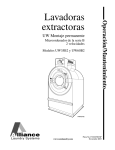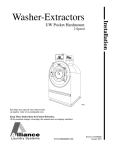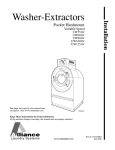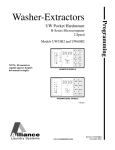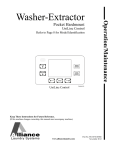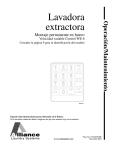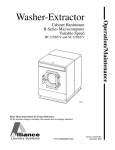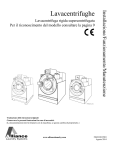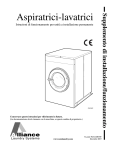Download Alliance Laundry Systems B-Series Operating instructions
Transcript
Washer-Extractors Operation/Maintenance UW Pocket Hardmount B-Series Microcomputer 2 Speed Models UW35B2 and UW60B2 ® NOTA: El manual en español aparece después del manual en inglés. PHM1379C PHM1379C www.comlaundry.com Part No. F232223R1 November 2005 Table of Contents Safety Information.............................................................................. Explanation of Safety Messages........................................................... Important Safety Instructions ............................................................... Key to Symbols..................................................................................... Operator Safety ..................................................................................... Safe Operating Environment ................................................................ Environmental Conditions ............................................................... Machine Location ............................................................................ Input and Output Services................................................................ 3 3 3 6 8 8 8 9 9 Introduction......................................................................................... Model Identification ............................................................................. Nameplate Location.............................................................................. Replacement Parts ................................................................................ Customer Service.................................................................................. 11 11 11 11 11 Operation............................................................................................. Machine Familiarization Guide ............................................................ Introduction........................................................................................... Electronic Control Unit.................................................................... Control Output Fuse Board .............................................................. Harnessing........................................................................................ Control Panel ........................................................................................ Summary of Major Features ................................................................. Rapid Advance Mode ...................................................................... Display Indicators................................................................................. Operating Instructions .......................................................................... 13 13 14 14 14 14 15 16 16 17 19 Maintenance ........................................................................................ Daily ..................................................................................................... Beginning of Day ............................................................................. End of Day ....................................................................................... Weekly.................................................................................................. Monthly................................................................................................. Quarterly ............................................................................................... Care of Stainless Steel .......................................................................... Daily Preventive Maintenance Checklist.............................................. Weekly Preventive Maintenance Checklist .......................................... Monthly Preventive Maintenance Checklist......................................... Quarterly Preventive Maintenance Checklist ....................................... 21 21 21 21 21 22 25 26 27 28 29 30 © Copyright 2005, Alliance Laundry Systems LLC All rights reserved. No part of the contents of this book may be reproduced or transmitted in any form or by any means without the expressed written consent of the publisher. F232223 © Copyright, Alliance Laundry Systems LLC – DO NOT COPY or TRANSMIT 1 Notes 2 © Copyright, Alliance Laundry Systems LLC – DO NOT COPY or TRANSMIT F232223 Safety Information Explanation of Safety Messages Precautionary statements (“DANGER,” “WARNING,” and “CAUTION”), followed by specific instructions, are found in this manual and on machine decals. These precautions are intended for the personal safety of the operator, user, servicer, and those maintaining the machine. DANGER DANGER indicates the presence of a hazard that will cause severe personal injury, death, or substantial property damage if the danger is ignored. WARNING WARNING indicates the presence of a hazard that can cause severe personal injury, death, or substantial property damage if the warning is ignored. CAUTION CAUTION indicates the presence of a hazard that will or can cause minor personal injury or property damage if the caution is ignored. Additional precautionary statements (“IMPORTANT” and “NOTE”) are followed by specific instructions. IMPORTANT: The word “IMPORTANT” is used to inform the reader of specific procedures where minor machine damage will occur if the procedure is not followed. NOTE: The word “NOTE” is used to communicate installation, operation, maintenance or servicing information that is important but not hazard related. Important Safety Instructions WARNING To reduce the risk of fire, electric shock, serious injury or death to persons when using your washer, follow these basic precautions: W023 1. Read all instructions before using the washer. 2. Refer to the GROUNDING INSTRUCTIONS in the INSTALLATION manual for the proper grounding of the washer. 3. Do not wash textiles that have been previously cleaned in, washed in, soaked in, or spotted with gasoline, kerosene, waxes, cooking oils, drycleaning solvents, or other flammable or explosive substances as they give off vapors that could ignite or explode. 4. Do not add gasoline, dry-cleaning solvents, or other flammable or explosive substances to the wash water. These substances give off vapors that could ignite or explode. 5. Under certain conditions, hydrogen gas may be produced in a hot water system that has not been used for two weeks or more. HYDROGEN GAS IS EXPLOSIVE. If the hot water system has not been used for such a period, before using a washing machine or combination washer-dryer, turn on all hot water faucets and let the water flow from each for several minutes. This will release any accumulated hydrogen gas. The gas is flammable, do not smoke or use an open flame during this time. 6. Do not allow children to play on or in the washer. Close supervision of children is necessary when the washer is used near children. This is a safety rule for all appliances. 7. Before the washer is removed from service or discarded, remove the door to the washing compartment. 8. Do not reach into the washer if the wash drum is moving. F232223 © Copyright, Alliance Laundry Systems LLC – DO NOT COPY or TRANSMIT 3 Safety Information 9. Do not install or store the washer where it will be exposed to water and/or weather. 10. Do not tamper with the controls. 11. Do not repair or replace any part of the washer, or attempt any servicing unless specifically recommended in the user-maintenance instructions or in published user-repair instructions that the user understands and has the skills to carry out. 12. To reduce the risk of an electric shock or fire, DO NOT use an extension cord or an adapter to connect the washer to the electrical power source. 13. Use washer only for its intended purpose, washing textiles. 14. Never wash machine parts or automotive parts in the machine. This could result in serious damage to the basket. 15. ALWAYS disconnect the washer from electrical supply before attempting any service. Disconnect the power cord by grasping the plug, not the cord. 16. Install the washer according to the INSTALLATION INSTRUCTIONS. All connections for water, drain, electrical power and grounding must comply with local codes and be made by licensed personnel when required. 17. To reduce the risk of fire, textiles which have traces of any flammable substances such as vegetable oil, cooking oil, machine oil, flammable chemicals, thinner, etc., or anything containing wax or chemicals such as in mops and cleaning cloths, must not be put into the washer. These flammable substances may cause the fabric to catch on fire by itself. 18. Do not use fabric softeners or products to eliminate static unless recommended by the manufacturer of the fabric softener or product. 20. Replace worn power cords and/or loose plugs. 21. Be sure water connections have a shut-off valve and that fill hose connections are tight. CLOSE the shut-off valves at the end of each wash day. 22. Loading door MUST BE CLOSED any time the washer is to fill, tumble or spin. DO NOT bypass the loading door switch by permitting the washer to operate with the loading door open. 23. Always read and follow manufacturer’s instructions on packages of laundry and cleaning aids. Heed all warnings or precautions. To reduce the risk of poisoning or chemical burns, keep them out of the reach of children at all times (preferably in a locked cabinet). 24. Always follow the fabric care instructions supplied by the textile manufacturer. 25. Never operate the washer with any guards and/or panels removed. 26. DO NOT operate the washer with missing or broken parts. 27. DO NOT bypass any safety devices. 28. Failure to install, maintain, and/or operate this washer according to the manufacturer’s instructions may result in conditions which can produce bodily injury and/or property damage. NOTE: The WARNINGS and IMPORTANT SAFETY INSTRUCTIONS appearing in this manual are not meant to cover all possible conditions and situations that may occur. Common sense, caution and care must be exercised when installing, maintaining, or operating the washer. Any problems or conditions not understood should be reported to the dealer, distributor, service agent or the manufacturer. 19. Keep washer in good condition. Bumping or dropping the washer can damage safety features. If this occurs, have washer checked by a qualified service person. 4 © Copyright, Alliance Laundry Systems LLC – DO NOT COPY or TRANSMIT F232223 Safety Information WARNING WARNING This machine must be installed, adjusted, and serviced by qualified electrical maintenance personnel familiar with the construction and operation of this type of machinery. They must also be familiar with the potential hazards involved. Failure to observe this warning may result in personal injury and/or equipment damage, and may void the warranty. Never touch internal or external steam pipes, connections, or components. These surfaces can be extremely hot and will cause severe burns. The steam must be turned off and the pipe, connections, and components allowed to cool before the pipe can be touched. SW014 SW004 WARNING CAUTION Ensure that the machine is installed on a level floor of sufficient strength and that the recommended clearances for inspection and maintenance are provided. Never allow the inspection and maintenance space to be blocked. SW020 This machine must be installed, adjusted, and serviced by qualified electrical maintenance personnel familiar with the construction and operation of this type of machinery. They must also be familiar with the potential hazards involved. Failure to observe this warning may result in personal injury and/or equipment damage, and may void the warranty. SW004 CAUTION Be careful around the open door, particularly when loading from a level below the door. Impact with door edges can cause personal injury. SW025 F232223 © Copyright, Alliance Laundry Systems LLC – DO NOT COPY or TRANSMIT 5 Safety Information Key to Symbols The lightning flash and arrowhead within the triangle is a warning sign indicating the presence of dangerous voltage. The exclamation point within the triangle is a warning sign indicating important instructions concerning the machine and possibly dangerous conditions. This warning symbol indicates the presence of potentially dangerous drive mechanisms within the machine. Guards should always be in place when the machine is in operation. 6 This warning symbol indicates the presence of possibly dangerous chemicals. Proper precautions should be taken when handling corrosive or caustic materials. This warning symbol indicates the presence of hot surfaces that could cause serious burns. Stainless steel and steam lines can become extremely hot and should not be touched. This warning symbol indicates the presence of possibly dangerous pinch-points. Moving mechanical parts can crush and/or sever body parts. © Copyright, Alliance Laundry Systems LLC – DO NOT COPY or TRANSMIT F232223 Safety Information PHM600N Figure 1 Safety decals appear at crucial locations on the machine. Failure to maintain legible safety decals could result in injury to the operator or service technician. Use manufacturer-authorized spare parts to avoid safety hazards. To provide personal safety and keep the machine in proper working order, follow all maintenance and safety procedures presented in this manual. If questions regarding safety arise, contact the manufacturer immediately. F232223 © Copyright, Alliance Laundry Systems LLC – DO NOT COPY or TRANSMIT 7 Safety Information Operator Safety Safe Operating Environment WARNING NEVER insert hands or objects into basket until it has completely stopped. Doing so could result in serious injury. SW012 To ensure the safety of machine operators, the following maintenance checks must be performed daily: 1. Prior to operating the machine, verify that all warning signs are present and legible. Missing or illegible signs must be replaced immediately. Make certain that spares are available. 2. Check door interlock before starting operation of the machine: a. Attempt to start the machine with the door open. The machine should not start with the door open. b. Close the door without locking it and attempt to start the machine. The machine should not start with the door unlocked. c. Close and lock the door and start a cycle. Attempt to open the door while the cycle is in progress. The door should not open. If the door lock and interlock are not functioning properly, call a service technician. 3. Do not attempt to operate the machine if any of the following conditions are present: a. The door does not remain securely locked during the entire cycle. b. Excessively high water level is evident. c. Machine is not connected to a properly grounded circuit. Do not bypass any safety devices in the machine. WARNING Never operate the machine with a bypassed or disconnected balance system. Operating the machine with severe out-of-balance loads could result in personal injury and serious equipment damage. Safe operation requires an appropriate operating environment for both the operator and the machine. If questions regarding safety arise, contact the manufacturer immediately. Environmental Conditions • Ambient Temperature. Water in the machine will freeze at temperatures of 32°F (0°C) or below. Temperatures above 120°F (50°C) will result in more frequent motor overheating and, in some cases, malfunction or premature damage to solid state devices that are used in some models. Special cooling devices may be necessary. Water pressure switches are affected by increases and decreases in temperature. Every 25°F (10°C) change in temperature will have a 1% effect on the water level. • Humidity. Relative humidity above 90% may cause the machine’s electronics or motors to malfunction or may trip the ground fault interrupter. Corrosion problems may occur on some metal components in the machine. If the relative humidity is below 30%, belts and rubber hoses may eventually develop dry rot. This condition can result in hose leaks, which may cause safety hazards external to the machine in conjunction with adjacent electrical equipment. • Ventilation. The need for make-up air openings for such laundry room accessories as dryers, ironers, water heaters, etc., must be evaluated periodically. Louvers, screens, or other separating devices may reduce the available air opening significantly. • Radio Frequency Emissions. A filter is available for machines in installations where floor space is shared with equipment sensitive to radio frequency emissions. • Elevation. If the machine is to be operated at elevations of over 3280 feet (1000 m) above sea level, pay special attention to water levels and electronic settings (particularly temperature) or desired results may not be achieved. • Chemicals. Keep stainless steel surfaces free of chemical residues. SW039 8 © Copyright, Alliance Laundry Systems LLC – DO NOT COPY or TRANSMIT F232223 Safety Information Input and Output Services DANGER Do not place volatile or flammable fluids in any machine. Do not clean the machine with volatile or flammable fluids such as acetone, lacquer thinners, enamel reducers, carbon tetrachloride, gasoline, benzene, naptha, etc. Doing so could result in serious personal injury and/or damage to the machine. SW002 • Water Damage. Do not spray the machine with water. Short circuiting and serious damage may result. Repair immediately all seepage due to worn or damaged gaskets, etc. Machine Location • Foundation. The concrete floor must be of sufficient strength and thickness to handle the floor loads generated by the high extract speeds of the machine. Refer to Installation manual. • Service/Maintenance Space. Provide sufficient space to allow comfortable performance of service procedures and routine preventive maintenance. Consult installation instructions for specific details. CAUTION Replace all panels that are removed to perform service and maintenance procedures. Do not operate the machine with missing guards or with broken or missing parts. Do not bypass any safety devices. SW019 • Water Pressure. Best performance will be realized if water is provided at a pressure of 30 – 85 psi (2.0 – 5.7 bar). Although the machine will function properly at lower pressure, increased fill times will occur. Water pressure higher than 100 psi (6.7 bar) may result in damage to machine plumbing. Component failure(s) and personal injury could result. • Steam Heat (Optional) Pressure. Best performance will be realized if steam is provided at a pressure of 30 – 80 psi (2.0 – 5.4 bar). Steam pressure higher than 125 psi (8.5 bar) may result in damage to steam components and may cause personal injury. For machines equipped with optional steam heat, install piping in accordance with approved commercial steam practices. Failure to install the supplied steam filter may void the warranty. • Drainage System. Provide drain lines or troughs large enough to accommodate the total number of gallons that could be dumped if all machines on the site drained at the same time from the highest attainable level. If troughs are used, they should be covered to support light foot traffic. • Power. For personal safety and for proper operation, the machine must be grounded in accordance with state and local codes. The ground connection must be to a proven earth ground, not to conduit or water pipes. Do not use fuses in place of the circuit breaker. An easyaccess cutoff switch should also be provided. WARNING Ensure that a ground wire from a proven earth ground is connected to the ground lug near the input power block on this machine. Without proper grounding, personal injury from electric shock could occur and machine malfunctions may be evident. SW008 Always disconnect power and water supplies before a service technician performs any service procedure. Where applicable, steam and/or compressed air supplies should also be disconnected before service is performed. F232223 © Copyright, Alliance Laundry Systems LLC – DO NOT COPY or TRANSMIT 9 Notes 10 © Copyright, Alliance Laundry Systems LLC – DO NOT COPY or TRANSMIT F232223 Introduction Model Identification Replacement Parts Information in this manual is applicable to these models: If literature or replacement parts are required, contact the source from which the washer-extractor was purchased or contact Alliance Laundry Systems LLC at (920) 748-3950 for the name of the nearest authorized parts distributor. A parts manual may be ordered by returning the reply card provided with each washer-extractor. UW35B2 UW60B2 Nameplate Location The nameplate is located on the cage wrap (below plumbing bracket) and on top rear of the control module. Always provide the machine’s serial number and model number when ordering parts or when seeking technical assistance. Refer to Figure 2. Customer Service For technical assistance, contact your local distributor or call: (920) 748-3121 Ripon, Wisconsin 1 2 A record of each washer-extractor is on file with the manufacturer. Always provide the machine’s serial number and model number when ordering parts or when seeking technical assistance. Refer to Figure 2. P U S H PHM598N 1 2 Top Rear of Control Module Cage Wrap (Below Plumbing Bracket) Figure 2 F232223 © Copyright, Alliance Laundry Systems LLC – DO NOT COPY or TRANSMIT 11 Introduction Model Number Familiarization Guide Sample Model Number: UW35B2OU80001 UW Model Number Prefix 35 Washer-Extractor Capacity (pounds dry weight of laundry) B Type of Electrical Control 2 Washer-Extractor Speed Capabilities O Electrical Characteristics U8 Design Series 0001 B = B – Control Option Identification (varies from machine to machine) UW35B2OU80001 00000000000 200 – 240 20 50 – 60 2/3 60 N/A 14 3 27 N/A 813 0.0 Drawings: ETL Listed Conforms To ANSI/UL Std. 1206, 3rd Ed Certified To CAN/CSA Std. C22.2 No.53-1968 EXAMPLE OF NAMEPLATE PHM599N PHM599N Figure 3 12 © Copyright, Alliance Laundry Systems LLC – DO NOT COPY or TRANSMIT F232223 Operation Machine Familiarization Guide The machine familiarization guide in Figure 4 identifies major operational features of the washer-extractor. 1 2 3 4 13 ® 5 6 7 12 8 11 10 9 PHM1379C PHM1379C 1 2 3 4 5 6 7 Emergency Stop Button Door Unlock Button Supply Valve Box Supply Dispenser Door Handle Door Box Door Latch Extension Arm 8 9 10 11 12 13 Door Latch Side Panel Rub Rail Shell Front Door Hinge Control Module Figure 4 F232223 © Copyright, Alliance Laundry Systems LLC – DO NOT COPY or TRANSMIT 13 Operation Introduction Control Output Fuse Board This control is composed of the electronic control unit and the control fuse board. Beyond this, there are wiring harnesses associated with the control. Only an authorized person should ever look inside the machine. Before accessing the control components, first TURN OFF POWER, then open the lid. This portion of the control contains the power supply for the control unit, and also the switching devices that power the components in the machine, all of which are on the output PC board. The output board has a cover for back of hand protection. It must be in place at all times during machine operation. The switching devices are controlled by the control unit, and are solid state components which provide two important benefits: 1) elimination of all the problems associated with electromechanical switching (contact wear, arcing and electromagnetic interference, etc.) with subsequent increased component life, and 2) enhanced electrical isolation of the control unit and the AC switching components. Electronic Control Unit This portion of the control contains the “intelligence” – namely, the micro-controller and the miscellaneous components on the printed circuit (PC) board. The board has a metal cover, which MUST be in place at all times during machine operation. Operation of the machine without this cover installed will void the warranty. The control unit monitors and responds to input, gives information about the status of the machine (which the control operates), and it monitors and responds to inputs from the user interface. The control provides signals to the control output unit, which in turn operates the components that control the machine functions. This is located behind the machine control panel. 14 Harnessing Wiring harnesses are modular – harnesses common to various configurations are similar, while those specific to a certain configuration can be added. There are harnesses for inputs to the control unit, for outputs from the control power/output unit to the machine components, and for the main incoming power to the control power/output unit. © Copyright, Alliance Laundry Systems LLC – DO NOT COPY or TRANSMIT F232223 Operation Control Panel 16 17 18 19 2 16 17 18 19 1 2 1 5 5 15 NORMAL 14 WASH ADD BLEACH 13 SPIN 12 PERM PRESS HOT HOT LIGHT SOIL VISA TM HOT WARM HEAVY SOIL UNIFORMS HOT HOT STAINED DELICATE HOT COLD RINSE 15 6 14 7 13 12 START DOOR 11 8 95C 95C 60C 60C 40C 40C 6 7 8 11 30C 3 4 9 DOMESTIC MODELS 3 4 PHM538R INTERNATIONAL MODELS CHM522N 1 2 3 4 5 6 7 8 9 10 < 9 10 < 10 Cycle 1 Cycle 2 Cycle 3 Cycle 4/Up Edit Cycle 5 Cycle 6* Cycle 7/Set Up (*) Keypad † Cycle 8/Down Edit START Keypad CLEAN FILTER Indicator LED (Active only for C80F, C80 and C125 models) PHM538R 11 12 13 14 15 16 17 18 19 Door Open LED Spin Cycle LED Rinse Cycle LED Add Bleach LED Wash Cycle LED Out-of-Balance Indicator Dot (Variable-speed only) High Water Level Indicator Dot Medium Water Level Indicator Dot Low Water Level Indicator Dot Figure 5 †Set Up (*) keypad is used in cycle programmings in program mode. Refer to Programming Manual. F232223 © Copyright, Alliance Laundry Systems LLC – DO NOT COPY or TRANSMIT 15 Operation Summary of Major Features LED for Machine Functions LED lights inform operator which machine function is active. DOOR LED lights to inform operator that the door can be opened or should be closed. The circle LED indicates that the filter needs cleaning. Water Levels Three (3) – Contacts from pressure switch (test cycle) Main LED display 4 digit LED display counts down cycle time. Lights in LED display indicate out-of-balance conditions and, in test cycle, water level. Display shows “01” as the final spin time. Cycle selection keypads Eight (8) cycle select keypads with LED indicator to show selected cycle. LED lights will flash to prompt user to press a keypad. START keypad Press to start a cycle after cycle selection is made. LED light will flash to prompt user to press keypad. Test Cycle with “Advance” For troubleshooting. Advance rapidly through test cycle by pressing the UP keypad. Refer to PROGRAMMING manual. Fill Temperatures Cold, Hot, Warm Supplies Five (5) or Four (4) with extra fill value option. Agitation Types Normal or Gentle Drain Options Normally open gravity drain Cycle Count 0 to 9999 cannot be reset – Rolls over after 9999 Rapid Advance Mode Rapid Advance can be enabled or disabled. Enabled allows user to advance through a cycle. Refer to Programming Manual. Table 1 16 © Copyright, Alliance Laundry Systems LLC – DO NOT COPY or TRANSMIT F232223 Operation Display Indicators Table 2 lists the various displays and what they mean. The operator should become familiar with these machine displays. Display Meaning tESt Diagnostic test cycle selected or enabled SPIn Spin (extract) step SUP1 Supply signal 1 (“S1” output), normally detergent SUP2 Supply signal 2 (“S2” output), normally bleach SUP3 Supply signal 3 (“S3” output), normally softener SUP4 Supply signal 4 SUP5 Supply signal 5 SdLY Spin coast (motor coasts after high speed extract) CFIL Cold Fill HFIL Hot Fill bFIL Warm Fill (cold + hot) bLCH Control will also light “add bleach” indicator CY__ Cycle number (followed by a space and number 1 through highest cycle number) norn Normal agitation selected gEnt Gentle (reduced) agitation selected For Wash speed forward (during test cycle) rEv Wash speed reverse (during test cycle) LO Low water level nEd Medium water level HI High water level CEL Display all temperatures in degrees Celsius FAr Display all temperatures in degrees Fahrenheit ___C The first 3 digits are reserved for temperature reading, C indicates “degrees Celsius” Table 2 F232223 © Copyright, Alliance Laundry Systems LLC – DO NOT COPY or TRANSMIT 17 Operation Table 2 (Continued) Display 18 Meaning ___F The first 3 digits are reserved for temperature reading, F indicates “degrees Fahrenheit” FILL “Fill error” – machine did not fill to programmed water level within 10 minutes; also displays during Rapid Advance Mode door “Door” opened during cycle USH1 “Wash 1” segment USH2 “Wash 2” segment USH3 “Wash 3” segment USH4 “Wash 4” segment rIn1 “Rinse 1” segment rIn2 “Rinse 2” segment rIn3 “Rinse 3” segment rIn4 “Rinse 4” segment (final rinse) donE Cycle has concluded drAI Drain selected for segment; also indicates in drain step during 2 speed version test cycle or during Rapid Advance Mode ---- Flashes for a period of time (for safety) after power up while keeping outputs OFF Erdn Drain error or drain count error (will display in certain models) ErFL Fill error count (will display in certain models) Adv Machine set up for Rapid Advance noAd Machine is not set up for Rapid Advance E Pr The number of times power has been interrupted during a cycle CyC Cycle counter © Copyright, Alliance Laundry Systems LLC – DO NOT COPY or TRANSMIT F232223 Operation Operating Instructions 1. When display shows “----,” washer-extractor is ready to be loaded with laundry. 2. Use left hand to press and hold the door unlock button located on the lower right front of the control panel. Refer to Figure 6. 4. Load the washer-extractor to full capacity whenever possible, but do not exceed the rated dry-weight capacity of the machine if the fabric to be washed is quite dense, closely woven, and heavily soiled. Overloading can result in an inferior wash. The operator may need to experiment to determine load size based on fabric content, soil content, and level of cleanliness required. Do not underload the machine. Underloading can result in premature bearing and sealing failure and outof-balance situations. WARNING NORMAL HOT PERM PRESS MACHINE MAY BE HOT AND CAUSE BURNS HOT ATTEMPT NO ENTRY UNTIL BASKET HAS STOPPED SERIOUS INJURY MAY RESULT WASH LIGHT SOIL ADD BLEACH VISA TM HOT WARM HEAVY SOIL UNIFORMS RINSE SPIN DOOR START HOT STAINED HOT HOT DELICATE COLD PHM601N Figure 6 PHM590N 3. Use right hand to turn door handle clockwise and swing the door left to open. Refer to Figure 7. Figure 8 WARNING Do not operate machine in a cycle with program keymode switch in program position. Program keymode switch must be in run position at all times, except when editing or programming cycle or setup information. W528 WARNING Do not operate machine in a cycle or if spinning with program keymode switch in program position. W529 PHM593N Figure 7 F232223 © Copyright, Alliance Laundry Systems LLC – DO NOT COPY or TRANSMIT 19 Operation CAUTION Be careful around the open door, particularly when loading from a level below the door. Impact with door edges can cause personal injury. SW025 NOTE: When washing items which may disintegrate or fragment, such as mop heads or sponges, use laundry nets to prevent drain blockage. IMPORTANT: To prevent out-of-balance conditions, premature wear or damage to machine when using laundry nets, use several small nets in a load. 5. When loading is complete, make sure that all fabric is inside the basket. 6. Close and lock the door. 8. Liquid supplies can be injected directly into the supply dispenser by an external chemical supply system. NOTE: Supply dispenser compartment cups must not be removed when an external chemical injection supply system is attached to the washerextractor. 9. Select the desired cycle. The corresponding LED indicator for that cycle will light. 10. Press the Start keypad. NOTE: The cycle number can be changed during the FIRST FILL ONLY by pressing another cycle select key. 11. At the conclusion of the cycle, the display will show ‘doNE’. The door can be unlocked. At this point the washer-extractor may be unloaded. 12. When the door is opened, the display will revert to showing “----” and the default cycle. 7. Dry supplies can be placed in the supply dispenser compartment cups prior to the start of each cycle. Be sure to return the supply dispenser compartment cups before the start of each cycle. 20 © Copyright, Alliance Laundry Systems LLC – DO NOT COPY or TRANSMIT F232223 Maintenance Routine maintenance maximizes operating efficiency and minimizes downtime. The maintenance procedures described below will prolong the life of the machine and help prevent accidents. WARNING Be careful when handling sheet-metal parts. Sharp edges can cause personal injury. Wear safety glasses and gloves, use the proper tools, and provide adequate lighting. SW035 4. Check door interlock before starting operation: a. Attempt to start the washer with the door open. The washer should not start with the door open. b. Close the door without locking it and attempt to start the washer. The washer should not start with the door unlocked. c. Close and lock the door and start a cycle. Attempt to open the door while the cycle is in progress. The door should not open. If the door lock and interlock are not functioning properly, call a service technician. End of Day CAUTION Replace all panels that are removed to perform service and maintenance procedures. Do not operate the machine with missing guards or with broken or missing parts. Do not bypass any safety devices. SW019 1. Clean the door gasket of residual detergent and all foreign matter. 2. Clean automatic supply dispenser and lid inside and out with mild detergent. Rinse with clean water. 3. Clean washer’s top, front, and side panels with mild detergent. Rinse with clean water. Daily, weekly, monthly, and quarterly checklists are provided at the end of this section. Laminate the checklists to preserve them for repeated copying. Operators and technicians are encouraged to add checks specific to their washer-extractor’s particular application. Where possible, space is provided on the checklists for this purpose. NOTE: Unload the washer-extractor promptly after each completed cycle to prevent moisture buildup. Leave loading door open at the end of each completed cycle to allow moisture to evaporate. The following maintenance procedures must be performed regularly at the required intervals. Weekly 1. Check the washer-extractor for leaks. Daily a. Start an unloaded cycle to fill the washerextractor. Beginning of Day 1. Inspect water inlet valve hose connections on the back of the washer-extractor for leaks. 2. Inspect steam hose connections for leaks (where applicable). 3. Verify that insulation is intact on all external wires and that all connections are secure. If bare wire is evident, call a service technician. F232223 4. Leave loading door open at the end of each day to allow moisture to evaporate. b. Verify that door and door gasket do not leak. c. Verify that the drain valve is operating and that the drain system is free from obstruction. If water does not leak out during the prewash segment, drain valve is closed and functioning properly. © Copyright, Alliance Laundry Systems LLC – DO NOT COPY or TRANSMIT 21 Maintenance Monthly NOTE: Disconnect power to the washer-extractor at its source before performing the monthly maintenance procedures. 1. Each month OR after every 200 hours of operation, lubricate bearings of the UW60. Refer to Figure 9 and Figure 10. DESIGN 5 AND LATER 1 PHM613N 1 Example of Bearing Lubrication Decal* * For U5 models, decal located on plumbing bracket. Figure 9 22 © Copyright, Alliance Laundry Systems LLC – DO NOT COPY or TRANSMIT F232223 Maintenance DESIGN 1-4 1 PHM616N PHM616N 1 Example of Bearing Lubrication Decal* * For U5 models, decal located on plumbing bracket. Figure 10 F232223 © Copyright, Alliance Laundry Systems LLC – DO NOT COPY or TRANSMIT 23 Maintenance The grease must have the following characteristics: Deflection. Refer to Figure 11. Increase spring tension to change belt span length. Belt tension measurements should be taken as close to the center of the belt span as possible. For every inch of span length, the belt should deflect 1/64 inch (0.40 mm). Thus, a belt with span length of 50 inches should deflect 50/64 inch (19.84 mm). An initial (run-in) force should be used to set the belt tension. An operating (normal) force should be used after the washer-extractor has been operated for a few hours. Refer to Table 4 for those values. • NLGI Grade 2 • Lithium-based • Water-insoluble • Anti-rusting • Anti-oxidizing • Mechanically stable The grease must have adequate base oil viscosity with one of the following ratings: • ISO VG 150 (135 – 165 cSt at 40°C or 709 – 871 SUS at 100° F) • ISO VG 220 (198 – 242 cSt at 40°C or 1047 – 1283 SUS at 100°F) • An SAE 40 rating is also acceptable as long as the cSt or SUS values are within the specified ranges. Pump the grease gun slowly, permitting only 2 strokes. Force of Deflection (lbs) Model 35 60 Frequency Run-In Normal 50 Hz 6 4 60 Hz 5 3 50 Hz 7.125 4.75 60 Hz 5.25 3.5 Table 4 NOTE: The UW35 2 speed bearings are permanently greased bearings and do not require lubrication. 2. Use the following procedures to determine if V-belts require replacement or adjustment. Call a qualified service technician in either case. a. Check V-belts for uneven wear and frayed edges. 1 b. After disconnecting power to the washerextractor and removing all panels necessary for access to the drive belt, use one of the following methods to verify that V-belts are properly tensioned. 2 Tension Gauge. Increase spring tension to change belt span length. The UW 2 speed belt tension should be set according to the data listed in Table 3. P044I P039I Tension Force (lbs*) Model Frequency 1 2 Deflection Span Length Basket/Extract Motor 35 60 50 Hz 45 – 55 Figure 11 60 Hz 40 – 50 50 Hz 70 – 90 60 Hz 70 – 90 c. Verify that V-belts are properly aligned by checking pulley alignment. Place a straightedge across both pulley faces. The straightedge should make contact with the pulleys in four places. Refer to Figure 12. * Tolerance: ± 5 pounds Set initial tension toward high end of these ranges. Table 3 24 © Copyright, Alliance Laundry Systems LLC – DO NOT COPY or TRANSMIT F232223 Maintenance Quarterly 1 NOTE: Disconnect power to the washer-extractor before performing the quarterly maintenance procedures. 1. Tighten door hinges and fasteners, if necessary. 2 3 4 5 2. Tighten anchor bolts, if necessary. 3. Verify that the drain motor shield is in place and secure. PHM544N 1 2 3 4 5 Drive Motor Drive Pulley Belt Straightedge Driven Pulley 4. Check all painted surfaces for bare metal. (Matching gray paint is available from the manufacturer.) • If bare metal is showing, paint with primer or solvent-based paint. • If rust appears, remove it with sandpaper or by chemical means. Then paint with primer or solvent-based paint. Figure 12 5. Clean steam filter, where applicable. 3. Remove back panel and check overflow hose and drain hose for leaks. a. Turn off steam supply and allow time for the valve to cool. 4. Unlock the hinged lid and check the supply dispenser hoses and hose connections. b. Unscrew nut. 5. Clean inlet hose filter screens: a. Turn water off and allow valve to cool, if necessary. c. Remove element and clean. d. Replace element and nut. b. Unscrew inlet hose and remove filter screen. c. Clean with soapy water and reinstall. Replace if worn or damaged. 6. Remove back panel and check overflow hose and drain hose for leaks. 7. Tighten motor mounting bolt locknuts and bearing bolt locknuts, if necessary. 8. Use compressed air to clean lint from motor. 9. Clean interior of washer-extractor, both basket and shell, by wiping with a water-soaked sponge or cloth. 10. Use compressed air to ensure that all electrical components are free of moisture and dust. F232223 © Copyright, Alliance Laundry Systems LLC – DO NOT COPY or TRANSMIT 25 Maintenance Care of Stainless Steel Maintain the natural beauty of stainless steel and prolong its service life by following these tips: • Ordinary deposits of dirt and grease can be removed with detergent and water. The metal should be thoroughly rinsed and dried after washing. Periodic cleaning will help to maintain the bright surface appearance and prevent corrosion. • Contact with dissimilar metals should be avoided whenever possible. This will help prevent galvanic corrosion when salty or acidic solutions are present. • Salty or acidic solutions should not be allowed to evaporate and dry on stainless steel. They may cause corrosion. Ensure that the stainless steel is wiped clean of acidic solution residues. • Deposits that adhere to the stainless steel should be removed, especially from crevices and corners. When using abrasive cleaners, always rub in the direction of the polish lines or “grain” of the stainless steel to avoid scratch marks. Never use ordinary steel wool or steel brushes on the stainless steel. Use stainless steel wool or soft non-metal bristle brushes. 26 • If the stainless steel appears to be rusting, the source of the rust may actually be an iron or steel part not made of stainless steel, such as a nail or screw. One remedy is to paint all carbon steel parts with a heavy protective coating. Stainless steel fasteners should be used whenever possible. • Discolorations or heat tint from overheating may be removed by scouring with a powder or by employing special chemical solutions. • Sanitizers or sterilizing solutions should not be left in stainless steel equipment for prolonged periods of time. They often contain chlorine, which may cause corrosion. The stainless steel should be cleaned and rinsed thoroughly of any solution containing chlorine. • When an external chemical supply system is used, make certain that no siphoning of chemicals occurs when the washer-extractor is not in use. Highly concentrated chemicals can cause severe damage to stainless steel and other components within the washer-extractor. Damage of this kind is not covered by the manufacturer’s warranty. Locate the pump below the washerextractor’s injection point to prevent siphoning of chemicals into the washer-extractor. Refer to the Installation manual. © Copyright, Alliance Laundry Systems LLC – DO NOT COPY or TRANSMIT F232223 Maintenance Daily Preventive Maintenance Checklist Machine ____________________________ Week of: ________________ Operator ___________________________ Days Checks 1 2 3 4 5 6 7 Observe All Safety Warnings! Beginning of Day 1. Inspect water inlet valve hose connections on the back of the washer-extractor for leaks. 2. Inspect steam hose connections for leaks (where applicable). 3. Verify that insulation is intact on all external wires and that all connections are secure. 4. Check door lock and interlock before starting operation: a. Attempt to start the washer with door open. b. Close the door without locking it and attempt to start the washer. c. Close and lock the door, start a cycle, and attempt to open the door while the cycle is in progress. 5. End of Day 1. Clean the door gasket of all foreign matter. 2. Clean automatic supply dispenser and lid. 3. Clean the washer’s top, front, and side panels. 4. Leave loading door open at the end of each day to allow moisture to evaporate. 5. 6. NOTE: Unload the washer-extractor promptly after each completed cycle to prevent moisture buildup. NOTE: Leave loading door open after each completed cycle to allow moisture to evaporate. F232223 © Copyright, Alliance Laundry Systems LLC – DO NOT COPY or TRANSMIT 27 Maintenance Weekly Preventive Maintenance Checklist Machine ____________________________ Month __________ Operator ___________________________ Week Ending: Checks / / / / / Observe All Safety Warnings! 1. Check the washer-extractor for leaks: a. Start an unloaded cycle to fill the washer-extractor. b. Verify that door and door gasket do not leak. c. Verify that the drain valve is operating. 2. 3. 4. 5. 6. 7. 28 © Copyright, Alliance Laundry Systems LLC – DO NOT COPY or TRANSMIT F232223 Maintenance Monthly Preventive Maintenance Checklist Month Machine ________________________ Operator _______________________ Checks Observe All Safety Warnings! Disconnect power to the washer-extractor before performing the monthly maintenance procedures. 1. Each month OR after every 200 hours of operation, lubricate bearings. 2. Determine if V-belts require replacement or adjustment: a. Check V-belts for uneven wear and frayed edges. b. Verify that V-belts are properly tensioned. c. Verify that V-belts are properly aligned. 3. Remove back panel and check hoses for leaks. 4. Unlock the hinged lid and check supply dispenser hoses and connections. 5. Clean inlet hose filter screens. Replace if worn or damaged. 6. Tighten motor mounting bolt locknuts and bearing bolt locknuts, if necessary. 7. Use compressed air to clean lint from motor. 8. Clean interior of washer-extractor, both basket and shell, by wiping with a water-soaked sponge or cloth. 9. Use compressed air to clean moisture and dust from all electrical components. 10. 11. 12. 13. 14. F232223 © Copyright, Alliance Laundry Systems LLC – DO NOT COPY or TRANSMIT 29 Maintenance Quarterly Preventive Maintenance Checklist Quarter Machine ________________________ Operator _______________________ Checks Observe All Safety Warnings! Disconnect power to the washer-extractor before performing the quarterly maintenance procedures. 1. Tighten door hinges and fasteners, if necessary. 2. Tighten anchor bolts, if necessary. 3. Verify that the drain motor shield is in place and secure. 4. Check all painted surfaces for bare metal. Repair, if necessary. 5. Clean steam filter, if applicable. 6. 7. 8. 9. 10. 11. 30 © Copyright, Alliance Laundry Systems LLC – DO NOT COPY or TRANSMIT F232223
































